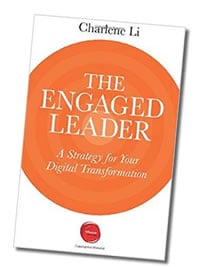
Interview with Charlene Li on her book “The Engaged Leader – A Strategy for your Digital Transformation.”
Among the topics we cover with Charlene: the meaning of engaged leadership, digital transformation, the essence of disruption, information management, and the crucial role of relationships.
After having worked as VP and Principal Analyst at Forrester Research, Charlene Li founded Altimeter Group.
Recently she started giving courses on a variety of transformation topics such as digital transformation and HR. Charlene is also a speaker on disruption, leadership, digital transformation, and – more recently – the future of work.
What really causes disruption is the change in power and balance when shifts in value happen between individuals, between companies, between customers, within companies, and inside ecosystems, and the value chain. (Charlene Li)
After “The Engaged Leader – A Strategy for your Digital Transformation” was published, she wrote her sixth book, “The Disruption Mindset: Why Some Organizations Transform While Others Fail.”
Altimeter Group employed several well-known analysts and thought leaders in various domains: content marketing expert Rebecca Lieb (now at Kaleido Insights and teaching in The Netherlands), Brian Solis (currently at Salesforce) and several others. Jeremiah Owyang, also at Kaleido Insights, worked for Altimeter Group as well.
Back to the essence: digital transformation and engaged leadership – and the four stages of digital transformation for leaders. This article is more or less a transcript of the interview but we added some additional comments and takeaways from other interviews and sources to complete the picture.
The purpose of going through the – painful – process of digital transformation
Charlene, thank you for granting me some time in such a busy period. For starters, can you tell us what “The Engaged Leader – A Strategy for Your Digital Transformation” is about in a nutshell?
Charlene Li: The book was written for leaders who are telling their organizations to be more digital.
To go out there and engage with their customers and their employees. And then they turn to themselves and realize they’re not doing it. They’re not actively engaging and listening.
A key part of my framework is listening, but I called it listening at scale. (Charlene Li)
Altimeter Group has been doing quite some work on digital transformation before. Brian Solis mainly tackled it from the customer experience viewpoint instead of an enterprise-wide approach. Why this focus? Shall we say that the customer in the broadest sense is really driving it all?
Charlene Li: We realized in the end that digital transformation needed an anchor to unify the organization.
What’s the purpose and the reason for going through this painful process of digital business transformation? We realized it had to be centered around this very dynamic digital customer.
Without understanding who that customer is and what the priorities are to serve that customer’s needs, your organization will be rudderless.
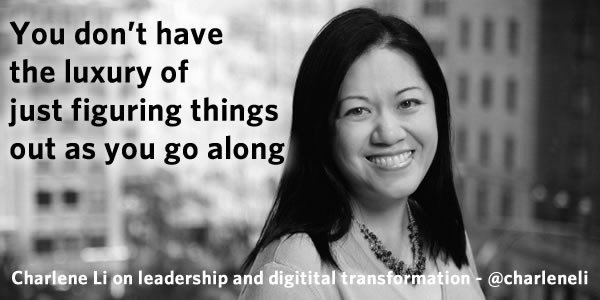
Focusing on the customer and the experience you want to create as an entire organization (is what it’s about).
The focus is across the enterprise but we’re giving it a purpose and a meaning. Why go through this digital transformation? The anchor: the customer.
Information: without it leaders fly blind
At the time of the interview, Charlene was about to kick off the “official” conference part of an edition of the AIIM conference in San Diego. As AIIM is an organization for information management professionals, we asked Charlene how she sees the link between digital transformation, the event’s and her book’s theme, and the role of data and information in this information age with its fast-growing ‘datasphere‘ on the other.
Charlene Li: Information is the lifeblood of relationships. You need to gather information in order to know who you are going to interact with, whether it’s an individual, a group, an audience, your employees…you need information in order to know where to start and where to take the relationship and the conversation.
Think about a leader walking into a situation with no information about what’s going on: they’re flying blind. The key here is not to have all the information but to have the right information to help your engagement at that particular point. It’s a reason why a key part of my framework is listening, but I called it listening at scale.
Think about all the information you have out there. How do you boil that down to just the most salient points so that you can use it to help you making decisions and exert your leadership?
Leadership and personal transformation
Back to leadership, the core theme of your book. It’s indeed often emphasized as being key for success to define and deploy a digital transformation strategy. Yet, leaders need to change and transform as well. Are they really ready to do so? What will it take you think?
Charlene Li: Charlene Li: We find that leaders might not be ready personally to go through this transformation, but they realize mentally that they have to do this.
They know that the organization is doing it, they’re pushing the organization but when it comes to themselves they’re very uncomfortable. In one part of the book I talk about the four stages of digital transformation for leaders.
They go through denial, then acceptance and they bargain and then finally they go through the transformation.
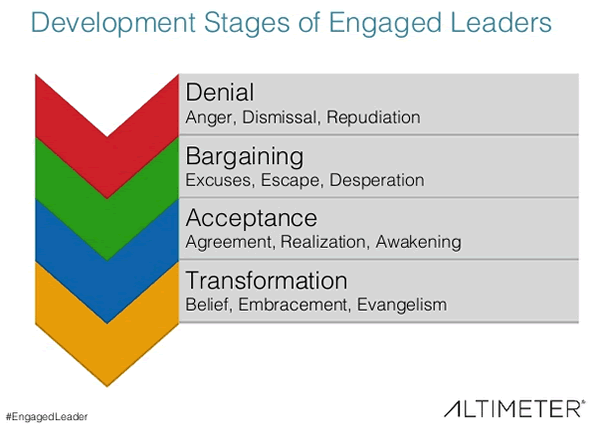
It takes a while and understanding where you are in those stages is really important personally. A leader also needs to be helped to go through this transformation (note: the scope of the book and of Charlene’s work). It’s good to know where they’re coming from. You cannot expect someone who is in denial to all of the sudden turn around. You need to go through these stages and go through the emotional acceptance of what it means to be a leader.
It is a very different way of leading and not one that they’re necessarily comfortable with. It requires that they (can) be vulnerable, engage into conversations, are able to make mistakes and own up to them. It’s a very different type of relationship.
Why leaders feel uncomfortable today
It sounds a bit like the stages of grief by Elisabeth Kübler-Ross. Maybe somewhat in line with the previous question: is networked leadership what matters more and what will happen to leaders who still operate in very hierarchic and self-protecting ways, sometimes even confusing leadership with power?
Charlene Li: Let’s talk about the power part of leadership. People often think that leadership comes from your position, your title, the fact that you have power in terms of being able to “control” people or to control a budget.
That still matters up to a point but you need to start engaging with people. The power really comes from your ability to influence and to inspire people.
We talk about the two sides of leadership. There is power and there is influence.
- Power is the ability to get things done and to command the resources.
- The influence side is about influencing people to actually get them exercise that power.
I think that more than anything else, what we’re finding in hierarchies where the power distance is actually shrinking (note: according to Charlene, listening also helps breaking down the power distance), more and more leaders are feeling uncomfortable because they don’t have that positional power anymore, it doesn’t matter as much in a digital environment.
It’s much more transparent and fast moving. And that’s the biggest problem that leaders often actually have. They don’t know how to engage. They don’t know what kind of relationships they have to form.
The engaged leader fits in all organizational structures
A while ago we interviewed a speaker at the AIIM conference, Filip Callewaert who is information manager at the Port of Antwerp (Belgium). He shared some great practice lessons on agility, lean thinking, small teams, start-up mentalities,… We also see different large firms restructure themselves to be able to work more in such ways. Is it that empowering, agile style that leaves room for experimentation we’re looking for?
Charlene Li: I believe that the engaged leader can work in any sort of organizational structure and at the speed at which they want.
I’m not asking for a whole turning over of organizations. It’s not that agile and lean aren’t very good, they are excellent concepts but not every organization is going to work in this way. Yet, I don’t want that to be an excuse for a leader to say “I don’t want to engage as we’re not doing those things”.
The question is, given where you are today and what you do, whether you can use digital and social tools to help you be a better leader and to help you accomplish your leadership goals.
That’s very different from the way most leaders are approaching it today. They are asking “how can I use these tools”, “what do I do with them”,… You have very specific leadership objectives but let’s step back and say: could you listen better to people, could you inspire people with stories that you can share and tell,.. With engagement you’re reaching out to somebody to emphasize a direction or a strategic purpose. Could that help people get more inspired and transform that relationship and build trust in you and your leadership?
These are classic leadership questions. They are not just organization and innovation.
But what we’re finding is that, if you want to be a more effective leader, you have to be able to use these (digital and social tools). Because that’s a way for you to scale your leadership, extend your leadership in ways you couldn’t before and, frankly, move a lot faster than the traditional hierarchies and the ways most organizations are structured.
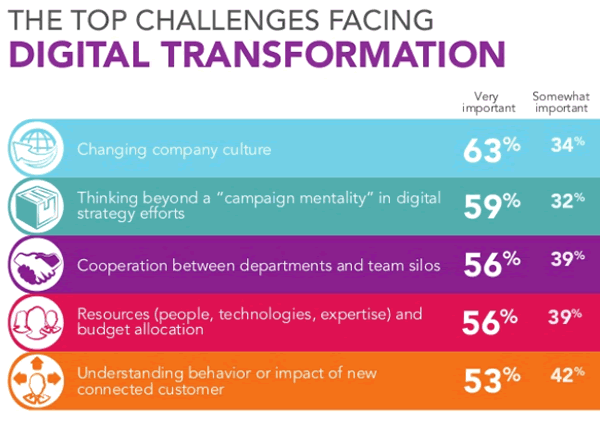
Disruption? Digital transformation is about relational value shifts
Back to digital transformation. You see the term popping up everywhere. In a way it’s defined as the next step beyond digitization. And on your personal blog I read that you describe yourself as “helping leaders thrive with disruption”. Transformation, disruption, they are umbrella terms. What is disruption for you? What is transformation?
Charlene Li: Disruption in the end is a shift in power in relationships. The reason why something is disrupted…it could be sitting there. A technology could be sitting there for years and not be disruptive. It suddenly becomes disruptive if somebody in the power of a relationship uses it to change the dynamics of a relationship. That is why it becomes disruptive.
Transformation and disruption have something very interesting in similar: they’re both human issues, both human problems to be tackled, not technology problems.
And that’s a mistake I think most people are making in this space. They think it’s a technology problem and it’s not, it’s absolutely a human problem. Our survey showed that 63% of people who are in a digital transformation process say that culture is the number one barrier. Culture. People. Leadership. These are the issues that hold companies back from being able to do a digital transformation, not the technology.
It’s the same with disruption. The thing that really causes disruption is the change in power and balance when shifts in value happen between individuals, between companies, between customers, within companies and inside ecosystems and the value chain. That’s when the pain comes in. Understanding that from a human perspective is key and a different way of thinking about it. And that’s why I’m so focused on leadership.
You have to ask yourself constantly what is the one thing that we could do differently today? (Charlene Li)
Digital transformation and prioritization – what’s your plan?
It’s really about people and culture yet at the same time we also have the processes and the technology. What strikes me there is that we talk so much about digital transformation (as the next step after digitization) but that there are still so many processes and information sources to digitize and connect. There often remains a lack of an integrated view and of connectivity. Where do you see the main challenges in that regard?
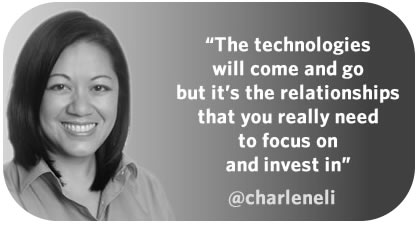
Charlene Li: I think the biggest challenge is seeing a clear picture of those relationships. It’s really mapping it out. Not trying to map it out in its full complexity and everything but prioritizing. Which are the most important pieces of information or processes that could really make a difference?
I often get asked what are the best integration or technology platforms, the best processes, the best practices,… What’s the best? Everyone wants that answer, we want that answer now so we can go and implement it.
What we found in our research is that there is no “best”. There are very specific use cases, you apply these specific use cases to specific solutions and then you start digging deeper and deeper. So, asking somebody and trying to determine which is the “best” out there, without FIRST understanding what your use case and the needs are is just foolhardy.
I know that people who are at the AIIM conference (the interview was conducted a few hours before that conference) understand this but all too often I see this kind of expedition like going to go out there and trying to just dig out everything. I’d like to see a more purposeful, intentional and strategic approach to answering these questions instead.
What can you transform, change, improve today? Aligned purpose
Look at where your biggest leaks are today, look at where you disappoint or lose customers or will lose them in the future, look at your key goals, look at what you have, look at what you need, build a roadmap, make sure that the teams are in place and the mentality to change it and execute. Is that it in a nutshell?
Charlene Li: I look at it this way: you have to ask yourself constantly what is the one thing that we could do differently today? Right now, here, today, not a month from now but today, to make a difference.
Once you tackled all those things – and this is just clean old hygiene – and then really look at all your options and at the feasibility. We’re looking at strategy for organizations and trying to decide what should they do first, second and third because a strategy in the end is always what you will do and what you won’t do.
Charlene Li: When it comes to information, data and processes it’s just as important to decide what you will do and just as important to decide what not to touch, what not to do.
And I often find that lack of prioritization. Unless you have that you’re going to be spending huge amounts of time arguing amongst yourselves. If you have defined your purpose and plan, however, you can start focusing on execution.
I often ask “where is your plan, what are your objectives” but they don’t have anything, they’re just doing it because they think they should or they read how they should do it but they don’t have a plan.
I think that’s just a waste of effort. You really need to be aligned. You don’t have the luxury of being able to just figure things out as you go along.
It’s all about relationships
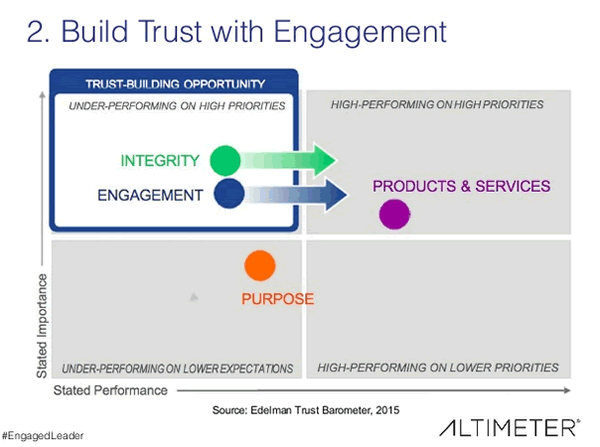
Thanks so much for your time. I know you’re busy so two final quick questions. What would you like people who’re about to listen to your keynote to take back home from the event and why should people really buy your new book.
Charlene Li: I hope that when people walk out of the door after my speech they remember one thing and one thing only: that the digital transformation – and your personal digital transformation – is all about relationships.
It’s the relationships that you can create and deepen. It’s not about the technologies.
Make no mistake. The technologies will come and go but it’s the relationships that you really need to focus on and invest in.
The engaged leader – a strategy for your digital transformation – what you need to know
Charlene Li: I encourage people to take a look at the book as it’s a quick read, it’s less than 100 pages and it’s something you can understand.
It’s a simple framework and also something that, frankly, your leaders in your organization would actually want to read because it’s so easy and quick. I wrote it specifically with that in mind and stripped it down to the most important basics so it’s really actionable. I hope that people will take a look and consider using it inside their organizations.
We hope the same. Here is again the link to “The Engaged Leader – A Strategy for your Digital Transformation“. Get it now – and start prioritizing and acting today. Thanks again, Charlene Li, for sharing your views and taking the time!
Originally posted on InformationDynamix


